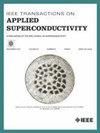用于弹道计算的离散长约瑟夫逊结低能流子检测
IF 1.8
3区 物理与天体物理
Q3 ENGINEERING, ELECTRICAL & ELECTRONIC
引用次数: 0
摘要
单通量量子(SFQ)数字逻辑具有典型的节能和快速特性,利用弹道和可逆原理的逻辑将为高效计算提供一个新的平台。我们正在研究长约瑟夫森结(LJJs),其中的SFQ和SFQ探测器,所有这些都是为了未来的弹道逻辑门实验。具体来说,我们将低能量SFQ发射到离散的ljj中,ljj由80个约瑟夫森结(jj)和连接电感组成。组件js的临界电流($I_{c}$)仅为7.5 $\mu \text{A}$。我们的LJJ的离散电感的测量表明,LJJ在约瑟夫森传输线的连续状态下工作,给出类似于连续LJJ的动态。Josephson穿透深度约为2.4个单元格,SFQ在LJJ中的剩余能量为$\approx$ 47 zJ。而SFQ发射器是相当标准的,SFQ探测器使用JJ临界电流只有$\approx$ 16 $\mu \text{A}$。为了了解电路中噪声的影响,我们在两个系统中进行了测量:1)在4.2 K下使用氦气浸泡探头;2)在3.5 K的无低温冰箱中。数据表明,在两个系统中,SFQ检测事件与SFQ启动事件是同步的。一个系统对另一个系统的额外抖动主要归因于检测器中的噪声。SFQ的穿越与弹道传播一致。本研究展示了在由离散元件组成的LJJs中创建低能sfq和检测这些sfq的方法,作为实现弹道可逆门的一步。本文章由计算机程序翻译,如有差异,请以英文原文为准。
Detection of Low-Energy Fluxons From Discrete Long Josephson Junctions for Ballistic Computing
Single-flux quantum (SFQ) digital logic is typically energy efficient and fast, and logic that uses ballistic and reversible principles will provide a new platform for efficient computing. We are studying long Josephson junctions (LJJs), SFQs within them, and an SFQ detector, all intended for future ballistic logic gate experiments. Specifically, we launch low-energy SFQ into discrete LJJs, made from an array of 80 Josephson junctions (JJs) and connecting inductors. The component JJs have critical currents ($I_{c}$ $\mu \text{A}$ $\approx$ $\approx$ $\mu \text{A}$
求助全文
通过发布文献求助,成功后即可免费获取论文全文。
去求助
来源期刊

IEEE Transactions on Applied Superconductivity
工程技术-工程:电子与电气
CiteScore
3.50
自引率
33.30%
发文量
650
审稿时长
2.3 months
期刊介绍:
IEEE Transactions on Applied Superconductivity (TAS) contains articles on the applications of superconductivity and other relevant technology. Electronic applications include analog and digital circuits employing thin films and active devices such as Josephson junctions. Large scale applications include magnets for power applications such as motors and generators, for magnetic resonance, for accelerators, and cable applications such as power transmission.
 求助内容:
求助内容: 应助结果提醒方式:
应助结果提醒方式:


